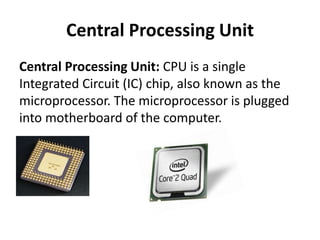
Revolutionary Engines: Exploring Central Processing Unit (CPU) Power
In the heart of every computing device lies a technological marvel known as the Central Processing Unit (CPU). Let’s unravel the layers of this revolutionary engine that powers our digital world.
Architectural Symphony: Decoding CPU Designs
At the core of CPU functionality lies its architectural design. From the classical von Neumann architecture to more modern designs like RISC and CISC, CPUs orchestrate the execution of instructions, processing data at lightning speed. Understanding these architectures unveils the intricacies of how CPUs perform their computational feats.
Clocking In: The Significance of CPU Clock Speed
CPU clock speed is the heartbeat of processing power. Measured in gigahertz (GHz), it determines how quickly a CPU can execute instructions. Higher clock speeds translate to faster data processing, making CPUs with elevated clock speeds coveted for tasks that demand rapid computational performance.
Cores Unleashed: The Multicore Revolution
In the quest for enhanced performance, CPUs now come equipped with multiple cores. Dual-core, quad-core, and even octa-core processors distribute the workload, allowing simultaneous execution of tasks. Multicore CPUs excel in multitasking scenarios, catering to the demands of modern computing, gaming, and content creation.
Cache Memory: A Swift Accessory
Cache memory is the swift messenger between a CPU and its RAM. L1, L2, and L3 caches store frequently accessed data, reducing the time it takes for the CPU to fetch information. The effectiveness of cache memory contributes significantly to a CPU’s overall speed and responsiveness.
Hyper-Threading: Simulating Multitasking Mastery
Hyper-Threading technology enhances CPU efficiency by simulating additional virtual cores. This allows a CPU to execute multiple threads simultaneously, optimizing performance for multitasking scenarios. Hyper-Threading is a game-changer for applications that can leverage parallel processing.
Integrated Graphics: CPU’s Visual Prowess
Modern CPUs often come with integrated graphics, negating the need for a separate graphics card in some scenarios. While not designed for intensive gaming, integrated graphics handle everyday visuals and contribute to power-efficient computing in laptops and entry-level desktops.
Power Efficiency: The Pursuit of Greener Computing
As technology advances, so does the emphasis on power efficiency. CPU manufacturers strive to strike a balance between performance and energy consumption. Techniques such as dynamic frequency scaling and low-power states contribute to creating CPUs that are not only powerful but also eco-friendly.
Advanced Instructions: Enhancing CPU Capabilities
CPUs are equipped with instruction sets that define the operations they can perform. Advanced instruction sets, like SIMD (Single Instruction, Multiple Data), accelerate parallel processing tasks, benefiting applications such as multimedia processing and scientific simulations.
Overclocking Adventures: Pushing CPU Limits
For enthusiasts seeking extra performance, overclocking is the name of the game. This involves pushing a CPU beyond its factory-set clock speeds. While overclocking can unleash additional power, it requires careful monitoring of temperatures and voltages to prevent overheating and damage.
The Future of CPUs: Into the Quantum Realm
As we venture into the future, the world of quantum computing beckons. Quantum CPUs, or qubits, promise revolutionary leaps in processing power by leveraging the principles of quantum mechanics. While still in the experimental stage, the potential of quantum CPUs signals an exciting chapter in computational history.
In the world of computing, Central Processing Unit (CPU) reigns supreme as the engine powering the digital revolution. From architectural intricacies to the promise of quantum computing, CPUs continue to shape the technological landscape, propelling us into an era of unprecedented computational possibilities.